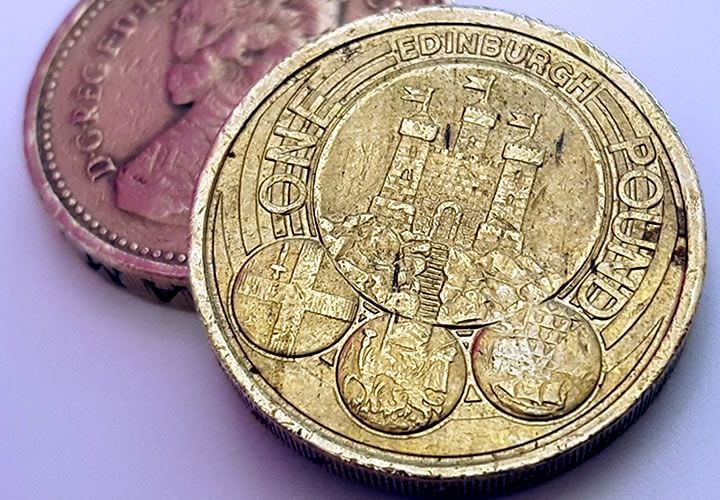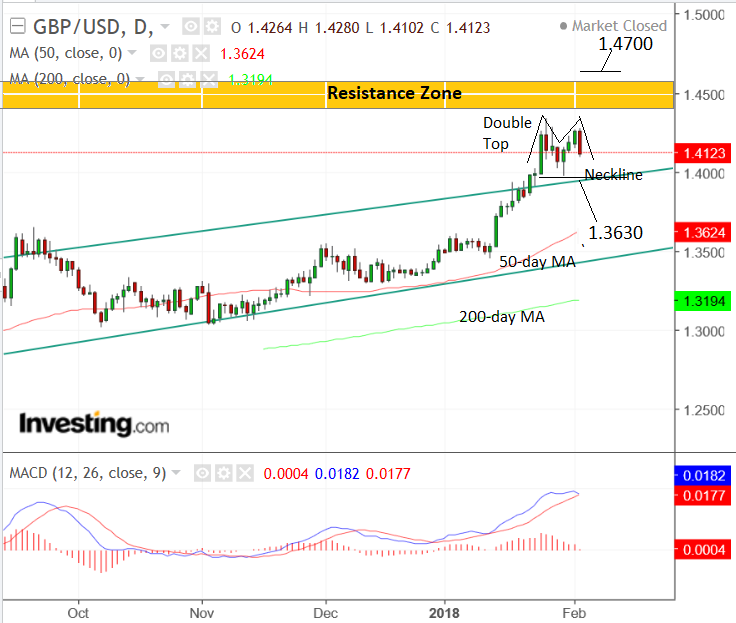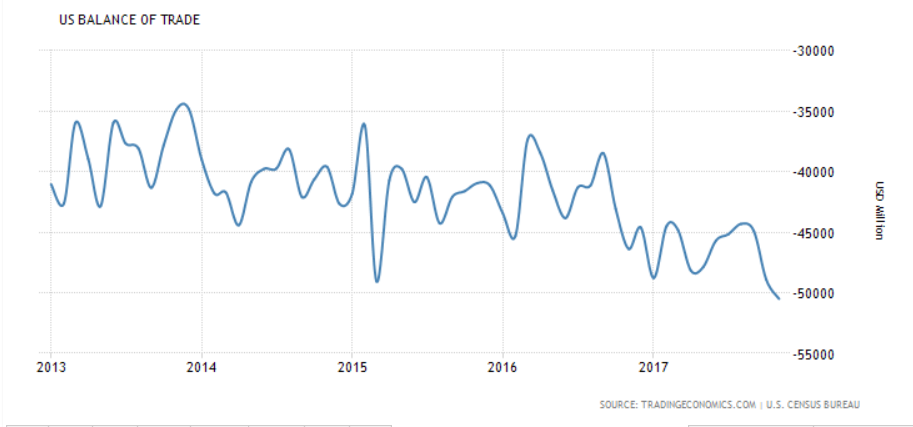Pound-to-Dollar Rate Forecast for the Week Ahead

Upside could be limited by a glass ceiling of chart resistance levels as we head into the new trading week.
One Pound can buy you 1.4123 Dollars at the last count, which is a distinct improvement on the 1st of January 2018, when it could only buy you 1.3515 USD.
An appreciation of over 5 cents is not to be sniffed at, especially with the 'Brexit of Damocles' still hanging over Sterling's head and economic data continuing to show that the US economy is growing at an impressive pace.
Given these seemingly improbable coincidences, the big question now is can the Pound hang onto its gains?
Our concern here is the technical picture - i.e. what does the structure of the market tell us about past performance, and importantly, future performance.
The exchange rate appears to be slap bang in the middle of a new range between the 1.4345 yearly highs and the 1.3975 lows, and its quite possible the pair will continue ranging for a while until the next major economic news story.
Although technically GBP/USD is in an unbroken uptrend which would normally be expected to continue higher, the location of the 200-week moving average (MA) just above the 1.4345 highs at 1.4400, is a major obstacle in the way of an extension higher.
Large moving averages such as the 200-week MA are a major impediment to further gains as they act as dynamic levels of support and resistance where prices often stall, pull-back or completely reverse.
This is partly because traders see them as exerting this influence and therefore take the opportunity to short the asset when it gets close to the MA, riding on the back of the expected pull-back in prices, and, in the end, actually encouraging it.
As such for confirmation of a continuation higher we would ultimately first wish to see a clear break above the 200-week MA.
Yet the obstacles don't stop with the 200-day at 1.4400 as the 1.4500 level could also cap gains.
Large round numbers like 1.4500 often lead to corrections or reversals as many investors see them as apt places to close their long trades and take profit, thus increasing supply at that level.
Further, the R1 monthly pivot is situated just above at 1.4543, and that too is expected to produce downwards pressure, as traders often target pivots - which are calculated from the open, high and low of the previous month and date back to the time of pit traders - to trade counter-trend and catch the pull-back.
The tripartite resistance ceiling just above the current market level is a tough resistance zone and we would ideally wish to see a clearance of it confirmed by a break above 1.4600 to expect a continuation of the uptrend to the next target at 1.4700.

As it is quite possible the exchange rate may not make it over the resistance zone and due to it already being quite extended, there is a possibility we could see some downside instead as buyers fall out of the picture.
The pair has also formed what looks like a double top reversal pattern consisting of two peaks at the same level.
If the pair breaks below the 1.3975 low where the 'neckline' of the double top pattern is situated, that would confirm a break lower of a similar length to the height of the double top, generating a downside target at 1.3630, which is reinforced by the fact that it is also just above support from the 50-day MA. at 1.3624.
Get up to 5% more foreign exchange by using a specialist provider to get closer to the real market rate and avoid the gaping spreads charged by your bank when providing currency. Learn more here.
Data and events for the Dollar
The Dollar roared higher last week after the release of positive employment and wage data on Friday and the market will be expecting more of the same in the week ahead.
Monday sees the release of the Non-Manufacturing ISM at 15.00 GMT, which is based on a survey conducted by the Institute of Supply Managers (ISM) of their members.
The ISM is deemed as a key source of knowledge for gauging the health of a given sector of the economy, in this case, Non-Manufacturing.
A score of above 50 indicates expansion of the sector and below contraction.
Monday's data is expected to show a slight decline to 57.2 from 57.3 previously (December).
Also of interest is the 'New Orders' component of the ISM report which is seen as a forward indicator for activity - it came out at 54.3 previously.
The other main release for the Dollar is the trade balance, out at 13.30 GMT on Tuesday, February 6, which is forecast to show the deficit widen to -52.0bn in December from -50.5bn previously.

The trade balance can impact on the Dollar because it suggests supply and demand dynamics in trade.
A rise in exports and a consequent narrowing of the trade deficit is good for the Dollar as it suggests demand for Dollars from buyers of US exports outweighs supply from US importers buying foreign imports - and vice versa for a fall in exports.
Data and Events to Watch for the Pound
The main event in the week ahead for the Pound is the Bank of England (BOE) rate meeting on Thursday, Feb 8 at 12.00 GMT.
Analysts do not expect a change in interest rates so the focus instead will be on attempting to guess when the next change will come by analysing voting patterns, the wording of the statement and governor Carney's verbal responses to questions in the press conference after.
If the evidence points to a rate rise getting more likely then the Pound will rise; if not then it will fall.
Brexit risks continue to cause uncertainty about the outlook and weigh on the BOE's reaction function, and given those risks have not changed substantially, little change is expected, and possibly a muted response from Sterling.
The other main event is the release of the BOE's Quarterly Inflation Report at the same times as the meeting, and given inflation is one of the main factors which lead to higher interest rates, and interest rates are positively correlated to the Pound this too could impact on Sterling.
If economic growth and inflation forecasts are revised higher expect Sterling to catch a bid.
"We have long-argued that interest rates would rise somewhat faster, and sooner than markets expecting. Recent comments by Governor Carney offer tentative support to this view and suggest that February’s Inflation Report could strike a more hawkish tone than is anticipated," says Paul Hollingsworth economist at Capital Economics.
Inflation is currently 3.0% and has been caused mainly by the depreciation of Sterling since the EU vote in June 2016. The BoE has said it is willing to allow inflaton to overshoot for a limited period before tackling it, however, Hollingsworth thinks they may start to show an impatience, given the stronger-than-expected performance of the economy. Such a change would be expected to lead to a modest rise in Sterling.
Other significant data in the coming week include the services sector PMI out on Monday at 9.30 and Halifax house price data for January out at 8.30 on Tuesday. Industrial, manufacturing and trade data round off the week.
Markets are expecting a reading of 54.3 from Monday's service sector PMI - anything better will likely set Sterling on a strong footing at the start of the new week, while disappointment could add to the bearish tone.
"While most of the early data was suggesting we could see the services sector run flat, the weak prints on both the manufacturing and construction PMIs last week now points to the Services PMI declining from 54.2 to 53.2, versus a consensus of 54.0, though we suspect that may likely drift lower by the time of release. The January PMIs so far suggest the adjustment in the housing sector persisted into January while more of the demand was coming from external sources rather than domestic, all suggesting no reason the Services PMI should outperform the softer January data," says a note on the matter from TD Securities.
The Halifax data may garner interest because last week's Nationwide data showed an unexpected surge in house prices in January, which lifted Sterling, and the market will be looking to the Halifax data to corroborate it.
Friday, meanwhile, sees the release of manufacturing and industrial production and the trade balance for December, all out at 9.30.
Markets are eyeing monthly industrial production to have slid 0.9% in December with the manufacturing production number showing an increase of 1.2%.
Trade data should show a balance of -£11.60BN as the UK continues to import more than it exports.
With regards to the above, the manufacturing data is expected to have the most impact on Sterling.
Get up to 5% more foreign exchange by using a specialist provider to get closer to the real market rate and avoid the gaping spreads charged by your bank when providing currency. Learn more here.











